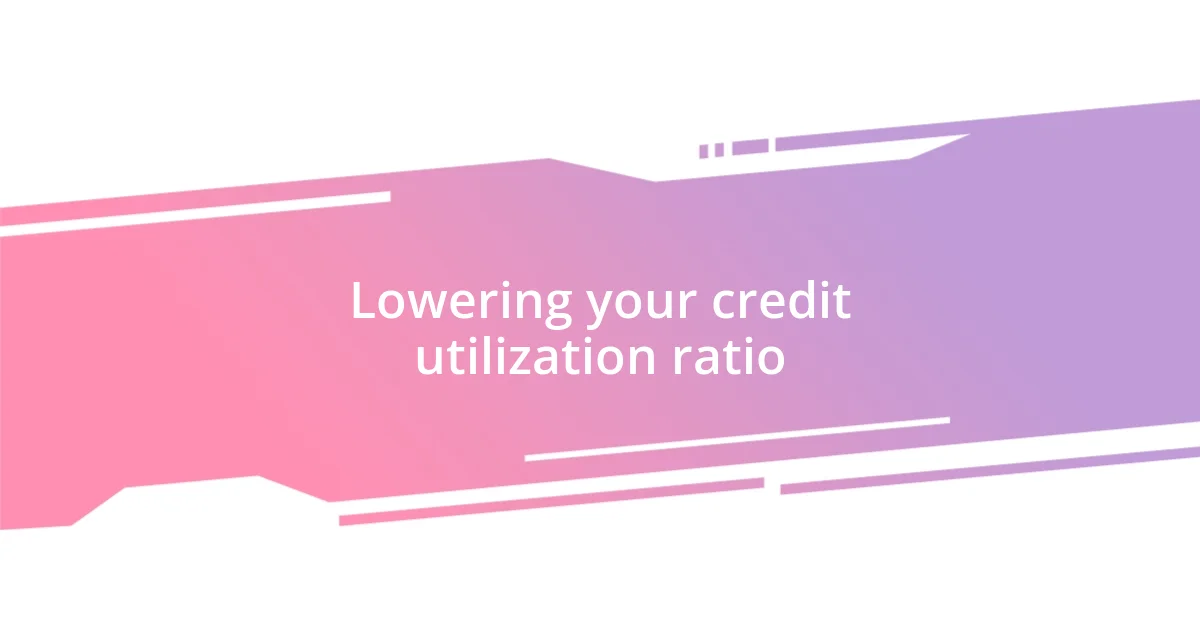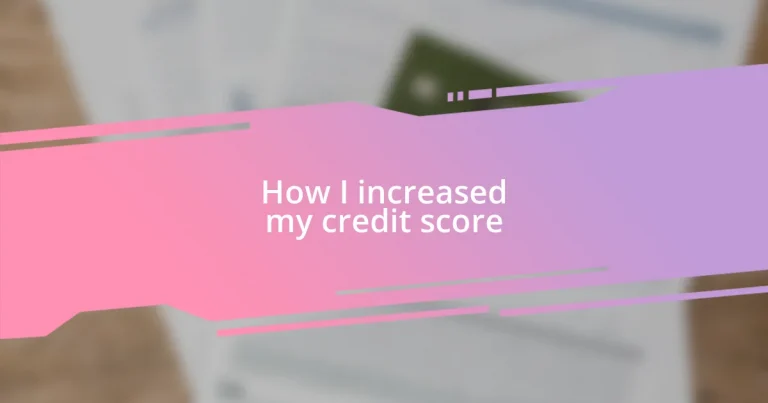Key takeaways:
- Understanding key credit score factors, like payment history (35%) and credit utilization (30%), is crucial for managing and improving your score.
- Implementing strategies such as automatic payments, tracking credit usage, and monitoring reports significantly enhanced the author’s credit journey.
- Utilizing credit-building tools, like secured credit cards and credit-builder loans, helped establish a positive payment history and boosted overall credit scores.

Understanding credit score factors
Credit scores might seem like a mysterious number, but understanding the factors that contribute to them can be pretty enlightening. For instance, I once learned that payment history accounts for about 35% of your score. Reflecting on my own journey, I remember the anxiety of missing a couple of due dates—those moments really drove home how crucial consistent, on-time payments are.
Another critical factor is credit utilization, which refers to how much of your available credit you’re using. I used to think that having a credit card meant I should max it out to show I was financially savvy. Let me tell you, that was a harsh lesson learned! Keeping your utilization below 30% is often advised, and I found it notably uplifting when I made that switch. It felt like lifting a weight off my shoulders—my score began to reflect my discipline.
Additionally, the length of your credit history plays a role, too. When I first started monitoring my score, I was shocked to realize that closing an old account after I paid it off negatively impacted me. Isn’t it interesting how decisions we view as harmless can matter more than we think? Understanding these factors not only empowers you but also transforms how you approach managing your credit overall.

Evaluating your current credit score
Evaluating your current credit score requires you to first gather all relevant information from the major credit bureaus. I vividly recall the day I pulled my report for the first time; it felt like opening a treasure chest filled with insights about my financial behavior. I noticed mistakes and outdated information that affected my score. This experience taught me the importance of staying on top of my reports, as even small inaccuracies can impact my creditworthiness.
Next, I learned to break down my score components. When I sat down to analyze my report, I realized my payment history and credit utilization were crucial areas. I still remember how I felt when I saw my credit utilization at 40%—I was shocked! Adjusting my spending habits to bring that number down to under 30% was a game-changer. It was a simple but powerful move that had a direct correlation with my score.
Lastly, I often suggest tracking your changes over time, which can be empowering. Initially, I was nervous about monitoring my score regularly, but it quickly became a rewarding habit. I set reminders to check my score quarterly, and watching my progress unfold felt like participating in my own financial journey. It’s amazing how much clarity this brings!
| Credit Score Component | Impact on Score |
|---|---|
| Payment History | 35% |
| Credit Utilization | 30% |
| Length of Credit History | 15% |
| New Credit | 10% |
| Types of Credit Used | 10% |

Building a positive payment history
Building a positive payment history is truly essential, and I’ve learned this firsthand. When I got my first credit card, I vividly remember the feeling of freedom it brought—a sense that I could indulge a bit. However, missing a payment deadline soon flipped that excitement into anxiety. The consequences were tough; I faced late fees and a dent in my score that took time to heal. Stepping into the disciplined habit of paying my bills on time was a turning point.
Here are some actions that helped me create a solid payment history:
- Set up automatic payments: This can eliminate the risk of forgetting a due date, which is something I found comforting.
- Use reminders on your phone: I would set alerts a few days before payments were due, giving me a cushion to prepare.
- Budget for bills: Allocating funds specifically for payments made me more aware of my expenses and ensured that I always had enough set aside.
- Prioritize payment of bills: Treating my credit obligations like must-dos rather than optional expenses changed my mindset.
- Maintain communication: If I ever faced unexpected financial struggles, reaching out to creditors to explain my situation often worked wonders.
Staying vigilant about my payment history transformed my credit journey from one of uncertainty to empowerment. I’ve truly come to appreciate how those little changes can build a lasting foundation for a healthier financial future.

Lowering your credit utilization ratio
Lowering your credit utilization ratio was a pivotal step for me, and I can’t stress enough how impactful it can be for anyone aiming to boost their credit score. I remember when I realized my utilization was high after indulging in a few unplanned purchases. It hit me like a cold splash of water—how had I let it get that high? Lowering it wasn’t just a number game; it felt like regaining control over my finances.
One of the most effective strategies I implemented was to pay down my credit card balances more frequently throughout the month. This approach helped keep my utilization low, and I found the shift remarkably rewarding. I even set a personal goal to pay off my cards before the statement closes, which made me more conscious of my spending and, frankly, a bit lighter in spirit. Reflecting on those small victories every time I checked my score felt like being on a self-improvement spree.
Additionally, I experimented with increasing my credit limits, which surprisingly worked in my favor. When I reached out to my credit card companies, I had mixed feelings—what if they said no? But they didn’t, and that increased limit lowered my utilization ratio without me changing my spending habits. I found it interesting how tackling my credit situation involved both strategic thinking and a dash of courage, reinforcing the idea that sometimes, we hold our own keys to financial success.

Managing credit inquiries effectively
Managing credit inquiries effectively can seem daunting at first, but I found it to be a game-changer for my credit score. When I applied for a new credit card, I felt that twinge of anxiety—would this inquiry hurt my score? I learned that while a hard inquiry could impact my score temporarily, it’s about the context. If managed well, you can mitigate the effects.
One strategy I adopted was bundling my credit applications. Instead of spreading them across several months, I focused on applying for multiple accounts within a short timeframe. This kept my inquiries grouped together instead of scattering them along my report, which helped minimize the impact. I remember how relieved I felt when I found out this approach could lessen the blow to my score while allowing me to secure the credit I needed.
Moreover, I became selective about application timing. I did my research before each application, ensuring that I met the eligibility criteria. This proactive approach not only made me more confident but also led to fewer unnecessary inquiries. Have you ever felt that rush of excitement before applying for credit? I know I did, but now I view it through a lens of strategy, leading to a more structured journey toward financial health.

Utilizing credit-building tools
To bolster my credit score, I found credit-building tools to be indispensable. One of my favorites was a secured credit card. Initially, I was skeptical; locking away my cash felt counterintuitive. However, I soon realized it was a smart move. By putting down a deposit as collateral, I used it just like a regular credit card. This allowed me to make small purchases and ensure timely payments, which ultimately reflected positively on my score. Have you ever felt unsure about trying something new? I certainly did, but stepping out of my comfort zone paid off in the long run.
I also dabbled with credit-builder loans. These are unique because they’re designed specifically to build credit. When I first learned about them, it felt a bit odd—essentially borrowing money that I wouldn’t access until the loan was paid off? But I gave it a shot. I put a small amount into a savings account that served as collateral for the loan. Paying it off consistently really helped me establish a positive payment history. It felt empowering to see my credit report improve with each installment paid.
Lastly, I can’t overlook apps that monitor credit scores. I downloaded one that provided real-time updates and credit tips, which kept me motivated. The excitement of tracking my score regularly made me more accountable for my financial decisions. Have you ever noticed how motivating it can be to see progress? For me, the thrill of watching my credit score rise became a rewarding experience that made managing my finances feel less like a chore and more like a personal challenge I was winning.

Monitoring your credit progress
Monitoring my credit progress was one of the most enlightening experiences in improving my credit score. I started by regularly checking my credit reports, which helped me identify any discrepancies or areas that needed attention. There was a moment when I discovered an old account that I’d forgotten about—it felt like unearthing a hidden treasure! Have you ever had that ‘aha’ moment when something unexpected pops up? It really motivated me to stay engaged with my credit journey.
In addition to my reports, I utilized credit score tracking tools. I vividly remember the excitement of logging in every month to see how my score had shifted. It was like a personal scoreboard that reflected my efforts. I found that certain behaviors, like paying down debt or lowering credit utilization, directly influenced my score, which kept me on my toes. It’s incredible how small, consistent actions yield significant results—don’t you feel that sense of accomplishment looking back on the progress you’ve made?
I also began setting specific goals to monitor my credit progress effectively. I created a simple spreadsheet to track my score changes over time and noted the steps I took to improve it. This helped me stay accountable and celebrate milestones, big or small, along the way. Reflecting on those moments, whether it was a modest increase or just meeting a credit utilization goal, fueled my motivation to keep going. Have you ever tried tracking your goals? It’s rewarding to see a visual representation of your success, isn’t it?














